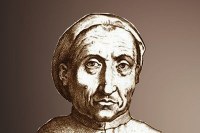Considered the leading representative of Renaissance Aristotelian thought, the philosophical centre of which had been built around the University of Padua and which was able to advance at the University of Bologna as well, thanks to Pomponazzi.
 Pietro Pomponazzi was born in Mantua to a wealthy family in 1462.
Pietro Pomponazzi was born in Mantua to a wealthy family in 1462.
He enrolled at the University of Padua relatively late, in 1484, and took courses in metaphysics, medicine and natural philosophy, completing his degree in 1487.
From 1488 to 1496 he was professor of philosophy in Padua.
In 1496, he took up a post at the sophisticated court of Carpi as logic tutor to Alberto III Pio, whom he followed when he was exiled to Ferrara.
When he returned Padua in 1499, he became professor of natural philosophy, taking the place of his teacher, the Averroist Nicoletto Vernia, who had died that year.
When Venice took back control of the city in 1509, tearing it from the League of Cambrai, lectures at the university were suspended and Pomponazzi accepted an invitation from Alfonso d’Este to transfer to the University of Ferrara. He took the opportunity to write his commentary on Aristotle’s De anima.
After returning briefly to Mantua (1511), he learned of the death of his teacher as well as rival thinker, Alessandro Achillini, and decided to take his position as professor of philosophy at the University of Bologna. He taught there from 1512 al 1525, in spite of heavy accusations of heresy and being disliked by important thinkers of the time.
In 1516, Pomponazzi published the treatise De Immortalitate animae, in which he argued that the human soul was not immortal as had been claimed could be proven through scholastic reason.
Just four years earlier, in 1512, the dogma of the immortality of the soul had been reasserted in Lateran Council V and it was strictly forbidden, with particular reference to university professors, to contradict this truth. The thinking of St Thomas (13th century), founder of scholasticism, persisted among the Church ranks. Drawing on the medieval interpretation of Aristotelian thought, Thomas had argued the simpliciter and immortal nature of the soul and asserted that this could be demonstrated through the indisputable alliance between faith and reason.
During the Renaissance, however, the new cultural circles had been analysing this principle for quite some time: in Ficino’s academy in Florence, using the Platonic theories that had come from the east, and in Padua, at the university, rereading Aristotle through the Arab-Hispanic philosopher Averroè (12th century).
Pietro Pomponazzi championed the latter school of thought, founding his speculation on the clear Avveroist distinction between faith and philosophy, the latter understood as the study of nature. In his De immortalitate animae, the philosopher interpreted the soul as a multiple entity, but united with and tied to the body’s fate, and so with and to the ephemeral natural of earthly life. He nevertheless admitted the limits of philosophy and did not exclude the fideistic truth of the immortality of the spirit which he described as having “the scent of immortality”.
This principle put the entire concept of Christian morality and the very existence of Heaven and Hell into crisis.
The text, therefore, was destined for the flames, while its author, thanks solely to the intercession of Cardinal Pietro Bembo, was able to defend himself against the heavy accusations.
In 1518, Leo X officially condemned the treatise and demanded that Pomponazzi retract his theories. Pomponazzi not only refused but he even went on the counter-attack against his adversaries, writing the Apologia (1518) and the Defensorium adversus Augustinum Niphum (1519).
After this stormy period, Pomponazzi managed to keep his professorship, but he had to avoid publishing anything that might cause a scandal. All that came out were treatises that lay outside the realm of theological speculation: De nutritione et augmentatione and De partibus animalium, both published in 1521, and De sensu, published in 1524, one year before he died.
The publication of his other two works of revolutionary philosophy, both written in Bologna, had to wait until 1556/57, when they were printed outside Italy, in Protestant Basel. The De incantationibus, in which he demonstrates that demonic forces do not exist, the groundlessness of miracles and the physical tie between the movements of the stars and human destiny, and De Fatu, in which he debunks the existence of free will and demonstrates our subjection to fate, understood as a natural necessity and not as divine predestination.
